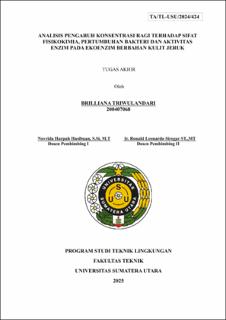| dc.description.abstract | Ecoenzyme is a product derived from the processing of organic waste, molasses, and water. Molasses, often referred to as sugarcane syrup, is a byproduct of repeated sugar crystallization processes that can no longer be processed into sugar. According to Retnaningtyas (2017), every ton of sugarcane has the potential to produce about 56.7 kg of molasses waste. To produce a good-quality ekoenzim product, a long fermentation process is required, lasting up to 90 days or 3 months. Therefore, new innovations are needed to accelerate the fermentation reaction process of ekoenzim, one of which is by adding yeast to the ecoenzyme solution. This study aims to analyze the effect of yeast concentration on the physicochemical properties, bacterial growth, and enzyme activity in ekoenzim produced from orange peels. The method used includes varying yeast concentrations (0, 1, 2, 3, 4%) in the fermentation process of orange peels for 40 days. Physicochemical properties such as pH, aroma, and color were measured. Bacterial growth was analyzed by counting the colony numbers on agar media. Enzyme activity was measured using titrimetric methods for lipase enzyme activity and spectrophotometry to determine amylase enzyme activity. The data were analyzed using multiple linear regression analysis to test the hypothesis and determine the significance of differences between groups. The results of this study showed that variations in yeast concentration and fermentation time had an effect on the physicochemical properties, bacterial growth, protease and lipase enzyme activity, while there was no effect on amylase enzyme activity in the ecoenzyme. | en_US |


